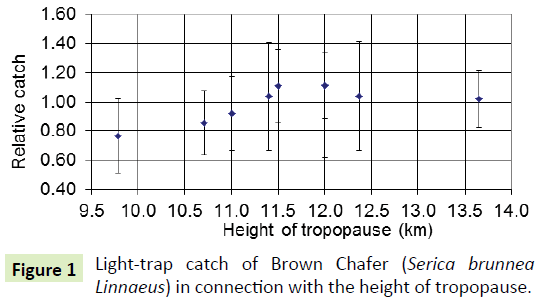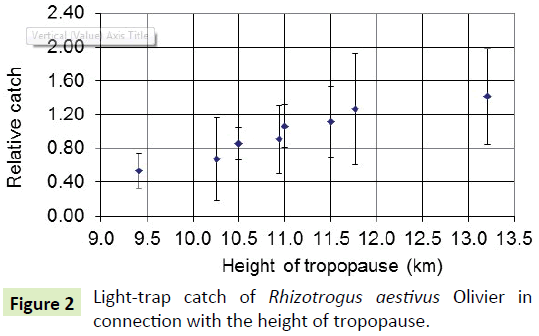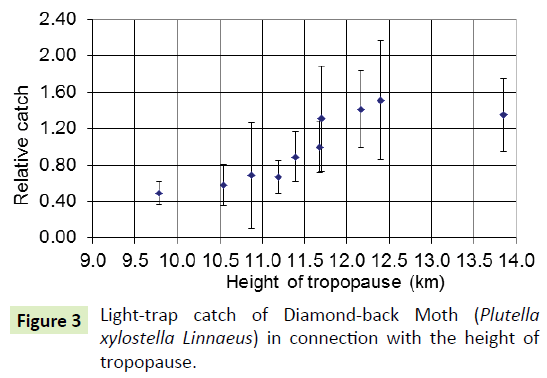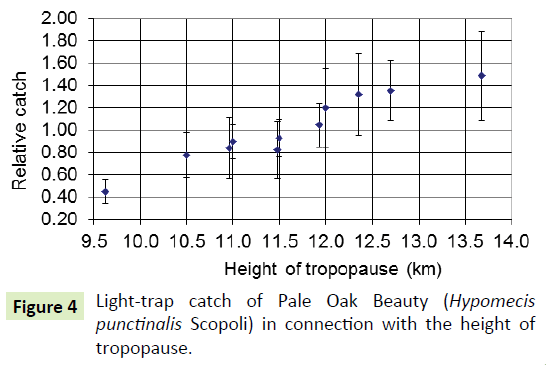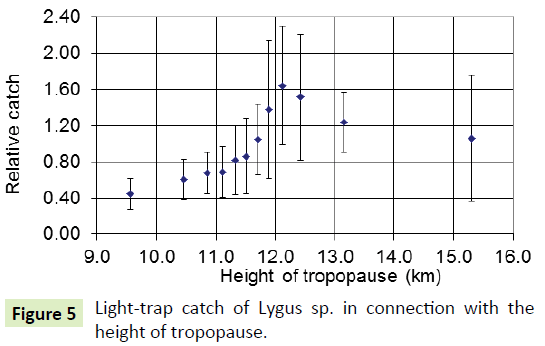ISSN : 2393-8854
Global Journal of Research and Review
Light Trapping of Coleoptera, Lepidoptera and Heteroptera Species in Relation to the Altitude of the Tropopause
László Nowinszky*, János Puskás and Miklós Kiss
Eotvos Lorand University, Savaria Campus Savaria Science Centre, Hungary
- *Corresponding Author:
- László Nowinszky
Eotvos Lorand University
Savaria Campus Savaria Science Centre
9700 Szombathely Károlyi Gáspár Square 4, Hungary
Tel: +3699518100
E-mail: lnowinszky@gmail.com
Received date: May 30, 2017; Accepted date: June 04, 2017; Published date: June 14, 2017
Citation: Nowinszky L, Puskás J, Kiss M.Light Trapping of Coleoptera, Lepidoptera and Heteroptera Species in Relation to the Altitude of the Tropopause. Glob J Res Rev. 2017, 4:2.
Abstract
The subject of our study is the success of light-trap catch of some insects (Coleoptera, Lepidoptera and Heteroptera) in Relation to the Altitude of the Tropopause. Groups were formed according to the height of the tropopause. The relative catch values of the investigated insects were grouped according to the heights of tropopause every day. Then we summarised, averaged and showed these values. We found a strong positive correlation between all of the investigated species and the altitude of tropopause.
Keywords
Tropopause; Light trapping; Coleoptera; Lepidoptera; Heteroptera
Introduction and Literature Background
Different changes can be noticed in the moderate zone air mass circulation, because there is a rise in altitude of the tropopause, and other factors also cause changes in the atmosphere (temperature, humidity, air pressure, speed and direction of wind) [1].
Troposphere is the separation surface between the troposphere and the stratosphere. Its height is greatly changeable at different times. The changes in altitude of tropopause contain more weather elements in accumulated form: air temperature, humidity, strength and direction of wind, air pressure and precipitation. In the presence of very cold air masses from the Arctic it may be five kilometres only, while in the presence of sub-tropical air it may grow to 16 kilometres. If the height of tropopause is more than 13 km, this fact often comes with subtropical air stream in the high. In this case very strong biological influence can be seen.
According to Örményi [2] the electric factors in the atmosphere have a significant influence, when subtropical air stream arrives at great altitude. During those days the 3Hz aspheric impulse number decreases, but cosmic radiation of the Sun will increase.
This fact will cause changes in the number of caught insects. It is well known that the activity of insects always increase in warm air, but decrease in cold one.
The predominance of negative ions cause decrease in the insect activity in the polar air, while the predominance of positive ions may increase the flight activity in the subtropical marine air [3]. As the changes in tropopause height cause significant changes in the weather in the lower part of atmosphere, we examined the efficiency of light-trap catch in relation with changes in the tropopause altitude.
In recent times we published some results about the relation between the efficiency of the light trapping and the height of the tropopause. We published the results with next insects: the Heart and Dart (Agrotis exclamationis L.), the Common Cockchafer (Melolontha melolontha L.), the Turnip Moth (Agrotis segetum Den. et Schiff.) and Fall Webworm Moth (Hyphantria cunea Drury) [4-6]. According to our results the subtropical air masses influenced differently the efficiency of trapping if these masses were found in the high. The result of light trapping of Turnip Moth (Agrotis segetum Den. et Schiff.) and Heart & Dart (Agrotis exclamationis L.) is high when subtropical air masses can be found, while the opposite influence can be seen if Saharan air mass arrived, because the catch is low. The catch result of Fall Webworm (Hyphantria cunea Drury) is the opposite. We made former investigations with light-trap catch of some species (European Corn-borer (Ostrinia nubilalis Hübner), Setaceous Hebrew Character (Xestia c-nigrum L.) and caddisfly (Trichoptera) species) to examine the connection with the tropopause height [7,8].
We could find only our publications in the literature which deals with similar investigations.
The height of the global-mean tropopause shows a steady increase since 1979 in re-analyses of numerical weather forecasts. In model simulations with anthropogenic forcing, changes in tropopause height can be detected roughly 20 years earlier than changes in surface temperature [9].
We think it is important to investigate the insects's response in relation with the changes of the height of tropopause.
Material
Data of the height of tropopause in Budapest were found in the Annals of the Central Meteorological Institute of the Hungarian Meteorological Service.
We used the catch data of the Hungarian Agricultural and Forestry light-trap network. All the catch was made with Jermy-type light traps. The collection data are shown in Table 1.
Table 1 The number and observing data of the examined species.
| Species | Years | Traps | Individuals | Data | Nights |
|---|---|---|---|---|---|
| Coleoptera, Scarabaeidae Serica brunnea Linnaeus, 1758 Brown Chafer | 1969-1974 | 8 | 7,713 | 499 | 288 |
| Coleoptera, Scarabaeidae Rhizotrogus aestivus Olivier, 1789 | 1969-1974 | 8 | 1,820 | 223 | 139 |
| Lepidoptera, Plutellidae Plutela xylostella Linnaeus, 1758 Diamond-back Moth | 1962-1966 | 26 | 4,602 | 534 | 353 |
| Lepidoptera, Geometridae Hypomecis punctinalis Scopoli, 1763 Pale Oak Beauty | 1962-1969 | 1 | 11,818 | 797 | 797 |
| Heteroptera, Miridae Lygus sp. | 1980-1998 | 14 | 51,953 | 3,339 | 1,728 |
The Serica brunnea Linnaeus is widespread species in the Carpathian Basin [10] wrote in his study the forest species of Hungarian forestry light-trap network were detected in the Bakony and Vértes Mountains and the sand in Danube-Tisza.
It can be found everywhere in the Carpathian Basin, but their damage is only significant in some regions.
The Rhisotrogus aestivus Olivier is collectible en masse mainly at sandy soils in Hungary (Kiskunság, Nyírség and around Budapest). Its swarming is expected in May [11,12]. It is mainly spread on sand soils. The larvae cause damage to sugar beet and potatoes.
The Plutella xylostella L. spread all over the world [13]. The most important host plants are the cabbages and rape.
The Hypomecis punctinalis ScopoliIt is very common in places in Hungary. The most important host plants are the oak (Quercus) and birch (Betula).
The material of caught bug species was not determined yet, but the majority belonged to these species: Lygus rugulipennis Poppius, 1911 (European Tamished Plant Bug) and Lygus pratensis Linnaeus, 1758 (Tamished Plant Bug) [14].
Methods
The Jermy-type light trap consists of a frame, a truss, a cover, a light source, a funnel, and a killing device. All the components are painted black, except for the funnel, which is white. A metal ring holds the funnel and a zinc coated tin are attached to the steel frame. The lid has a diameter of 100 cm. The top diameter of the funnel is 32 cm, the bottom is 5 cm and the height is 25 cm. The light source was a 100W normal light bulb which was laid under a metal cover (0:1 m) at 200 cm above the ground. Most traps were operated without a bow and the insect material was fed by a funnel under the bulb into a bowl. In each case, chloroform was used as a killer. Traps were held every night from April to October. An automatic turn-on/switched-off technique provided the capture of both twilight and night insects. The light-traps are operational from 6 pm. (UT) to 4 a.m. every night of the year, regardless of weather, or the time of sunrise and sunset. All the insects trapped during the course of a night go into the same collecting jar [15]. So a single set of data will represent the nightly catch result at the given observation site [16].
Basic data were the number of individuals caught by one trap in one night. The number of basic data exceeded the number of sampling nights because in most collecting years more light-traps operated synchronously [16].
The size of the populations of different observers are in different places, and the modifying factors are not the same all the time and location of the trapping, it is easy to see that the same number of items you can capture an entirely different proportion of two different observers place or time, the population studied. To solve this problem, the application offers to the relative catch values [16]. The relative catch (RC) is for a given sampling unit time (one hour or one night) and number average equivalenttime sampling unit relative to the number of generations beforebassoon individuals divided. If the number of specimens is equal to the average value of the relative catch is 1.
The relative catch data were classified into the appropriate phase angle groups. The phase angle groups and the corresponding catch data were organized into classes. Their number was determined according to Sturges' method [17] using the following formula:
k=1+3.3 * 1g n
Where: k=the number of groups, n=the number of observation data.
The relative catch values were sorted according to the respective diurnal values of the height of tropopause and then averaged and depicted. The figures also show the confidence intervals.
Results and Discussion
Our results are visible in Figures 1-5. The illustrated Figures show that the collection results of the different species are similar in connection with the height of the tropopause. Various tropopause heights have different weather conditions in the lower air layers [18]. In summer the cool air decreases the flying activity of insects in contrast, it is growing in warm air.
We have discovered a close positive correlation between the height of the tropopause and the number of light trapped of all five species. The catch, however, is slightly different from species to species and peaks ranged from 10.5-13.6 km. This behaviour is not linked to the taxonomic position. However, our previous works gave somewhat different results in the current one. The higher values of tropopause cause higher catching results for the following species:
Lepidoptera: Noctuidae: Xestia c-nigrum L., First rising then falling: Lepidoptera: Crambidae: Ostrinia nubilalis Hbn [7].
Coleoptera: Melolontidae: Melolontha melolontha L., Lepidoptera: Noctuidae: Agrotis exclamationis L., Trichoptera: Limnephilidae: Goera pilosa Fabr [19].
Conversely, the higher values of tropopause were lower for the following species: Lepidoptera: Crambidae: Loxostege sticticalis L., Nomophila noctuella, Den. et Schiff. [19], Trichoptera: Limnephilidae: Limnophilusa affinis Curtis [8].
The relationship between the height of the tropopause and the weather of lower air is not fully known. Our past works results are partially contradicted by our present results. The cause of this controversy must be further explored.
References
- Lorenz DJ, DeWeaver ET (2007)Tropopause height and zonal wind response to global warming in the IPCC scenario integrations. Journal of Geophysical Research: Atmospheres 112: 10.
- Orményi I (1984) Influence of 3 Hz atmospheric electromagnetic radiation for people on same territories of life (in Hungarian).
- Orményi I (1967) Atmospheric ionization examinations surrounding of Lukács bath (in Hungarian). Magyar Balneoklimatológiai Egyesület Évkönyve pp: 105-129.
- Puskás J, Nowinszky L (2000) Light-trap catch of Common Cockhafer (Melolontha melolontha L.) depending on the height of tropopause. Proceedings of Berzsenyi Dániel Teacher Training College Szombathely, Natural Science Brochures 5: 5-8.
- Örményi I, Nowinszky L, Puskás J (1997) Light trapping of heart-and-dart moth (Scotia exclamationis L.) connected with air masses and height of tropopause (in Hungarian). Növényvédelem 33: 459-471.
- Puskás J, Nowinszky L (2011) Light-trap catch of harmful insects in connection with the height of tropopause.Advances in Bioresearch 2: 101-103.
- Nowinszk L, Puskás J (2013) Light-trap catch of the European Corn-borer (Ostrinia nubilalis Hübner) and Setaceous Hebrew Character (Xestia c-nigrum L.) in connection with the height of tropopause. Global Journal of Medical Research Veterinary Science and Veterinary Medicine 13: 41-45.
- Nowinszky L, Puskás J, Kiss O (2015) The efficiency of light-trap catches of caddisfly (Trichoptera) species in connection with the height of tropopause in Hungary (Central Europe). Molecular Entomology 6: 1-7.
- Sausen R, Santer BD (2003) Use of Changes in Tropopause Height to Detect Human Influences on Climate Zeitschrift 12: 131-136.
- Tóth J (1975) Investigation of population dynamics of Coleoptera species with light-traps. University of Sopron, Hungary.
- Járfás J, Tóth J (1977) Forecast and protection of the damaging Melolontha species in vineyard (in Hungarian). Szőlőtermesztési Agrokémiai Tájékoztató Kecskemét 3: 2-7.
- Tóth J (2014) Forest Entomology (in Hungarian). Agroinform Kiadó. Budapest.
- Czencz K (1973) Autecological investigations with Diamond-back Moths (Plutella maculipennis Curt, Lep: Plutellidae (In Hungarian). Növényvédelem 9: 243-246.
- Kondorosy E (1997) The selectivity of the light trap to the bugs (Heteroptera) (in Hunga-rian). III. Ifjúsági Tudományos Fórum. PATE Georgicon Mezőgazdaságtudományi Kar pp: 13-19.
- Jermy T (1961) Investigation of the swarming of harmful insects using light-traps (in Hun-garian). A Növényvédelem Időszerű Kérdései 2: 53‑61.
- Nowinszky L (2003) The Handbook of Light Trapping. SavariaUniversity Press, Szombathely.
- Odor P, Iglói L (1987) An introduction to the sport's biometry (in Hungarian). ÁISH Tudo-mányos Tanácsának Kiadása. Budapest pp: 267.
- Örményi I (1984) Influence of 3 Hz atmospheric electromagnetic radiation for people on same territories of life (in Hungarian).
- Puskás J, Nowinszky L, Mészáros Z (2014) Light-Trap Catch of Moth Species of the Becse-Type Light Trap in Connection With the Height of the Tropopause. Nature & Environment 19: 73-78.
Open Access Journals
- Aquaculture & Veterinary Science
- Chemistry & Chemical Sciences
- Clinical Sciences
- Engineering
- General Science
- Genetics & Molecular Biology
- Health Care & Nursing
- Immunology & Microbiology
- Materials Science
- Mathematics & Physics
- Medical Sciences
- Neurology & Psychiatry
- Oncology & Cancer Science
- Pharmaceutical Sciences
